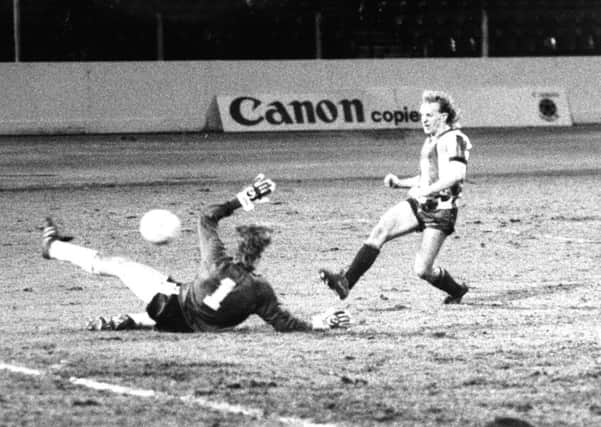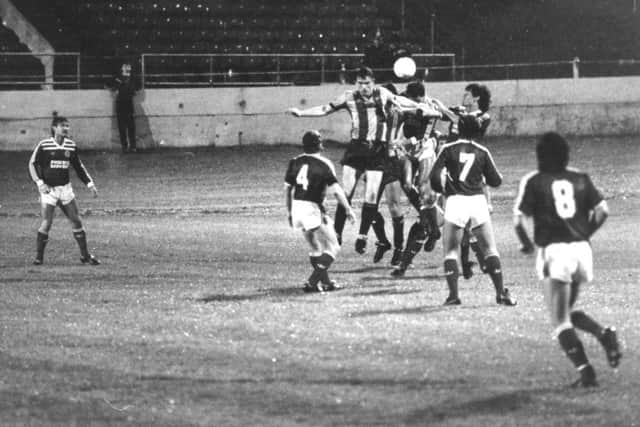Bygones: Odsal exile in aftermath of fire compounded troubles for Bradford City


With a near exemplary seven wins from eight home games in Division Two, the Bantams boasted a record only a few clubs could come close to matching.
Chelsea and Liverpool, for instance, had more victories to their name in the top flight from more games, as had Swindon Town in the basement division. But what made Bradford’s near perfect record all the more remarkable as Christmas, 1985, approached was the Yorkshire club hadn’t played a true ‘home’ game in more than six months.
Advertisement
Hide AdAdvertisement
Hide AdThe fire disaster that had claimed 56 lives the previous May meant Valley Parade was out of action, leaving City to lead a nomadic existence.


Initially, that involved lodging at the home of neighbours, Huddersfield Town and Leeds United, before setting up a temporary base at Odsal.
Which is how Trevor Cherry, the club’s manager for a five-year spell that included the day of the fire, found himself looking out across the vast bowl of a rugby league stadium that had once held more than 100,000 and wondering just how much longer his side could keep defying the odds.
“It was a horrendous time for everyone,” said the former England international when speaking to The Yorkshire Post last week. “Obviously, the entire city was going through a traumatic time after the fire. Bradford was in shock.
Advertisement
Hide AdAdvertisement
Hide Ad“We were the same as a club but we also had to try and somehow focus on the football. We started the season at Leeds Road and Elland Road, and I was happy with that from a football point of view.
“They were proper football grounds and decent pitches. Our so-called ‘home’ games did still feel like away games but we could cope.
“There was, though, a big push to get back to Bradford. The supporters wanted it, which I fully understood. And the board wanted it, too.
“So, I was taken up to Odsal one day by the chairman, Stafford (Heginbotham), and a local councillor. I took one look at the pitch and said, ‘I wouldn’t walk my dog on this’.
Advertisement
Hide AdAdvertisement
Hide Ad“It was awful. Rugby league was played there so the grass was too long and there were no corners to the pitch because of the speedway track. I was told plastic turf would be brought in on a matchday. After making clear my feelings on the place, the councillor told me that £6m had been spent on Odsal over the past two years. I honestly couldn’t see where!”
City’s tenure at Odsal began with a downpour and a defeat, as Brighton & Hove Albion claimed a 2-0 League Cup victory on October 8.
Many of the 5,368 supporters left soaked to the skin thanks to only the main stand having cover and such an inauspicious start set the tone for what lay ahead, certainly in terms of comfort levels.
Situated in the south of the city and exposed to the elements, Bradford Northern’s home had long since developed a reputation as a venue for only the hardiest of sports fans. The huge, sweeping terraces that made up two sides of the bowl plus one end taken up by the speedway pits meant the 4,000 crowds Northern attracted at the time rattled around. City’s crowds were marginally higher in those first few games but, even so, Cherry recalls life being hard.
Advertisement
Hide AdAdvertisement
Hide Ad“The atmosphere was non-existent,” said the 67-year-old. “We came out of the dressing rooms to nothing. The place was freezing cold, the wind blew everywhere and it just felt totally alien to what a football ground should be. Not a nice place to be, at all.
“The dressing rooms were about the only decent thing in there. But, once you left them, it was like watching a reserve game. And winter made it even bleaker. There was one game that sticks out, when we played Nottingham Forest (in the League Cup). I always got on well with Brian Clough from my time at Leeds and I remember him coming up to me before the match and saying, ‘This is one hell of a place you have here…’ Then, he pulled a face.
“I knew what he meant. I am sure every other visiting manager felt the same. The plus for them was they only had to play on it once a season, whereas we were there every home game. So, I didn’t have any sympathy for them. Nor did they have much for us, I’d imagine. Cloughy’s Forest beat us 5-0 that night.”
By the end of the season, City had won 14 of their 21 ‘home’ games - a remarkable feat underlined by only champions Norwich City being able to better that tally in the second tier.
Advertisement
Hide AdAdvertisement
Hide AdA 13th place standing under such trying circumstances was also hugely commendable for a newly-promoted club, as Cherry readily admits.
“The lads did brilliantly to cope with it all,” he added. “I don’t just mean the football side of things, I mean everything.
“The fire had left the city devastated and the players had to pick up the pieces. I remember when we started playing reserve games back at Valley Parade during that first season after the fire and you just couldn’t help but stare at where the stand had been and think about that awful day.
“As a club, I can’t remember us getting any help from the outside. None at all. Nowadays, we would probably have been inundated with calls of assistance. Probably, too much, if I am honest. Psychologists would be saying the players can’t play for six months and things like that.
Advertisement
Hide AdAdvertisement
Hide Ad“But, back then, I can’t remember one bit of help from the FA, the PFA or all the others who really should have stepped in.
“Instead, it was left to individuals in football. Brian Flynn was the first to ring me and the second was Ron Atkinson. He was manager of Manchester United at the time and went to the trouble of getting my number from someone.
“He called on the morning after the fire to say he and his club were there for us. ‘Anything Manchester United can do, just get in touch.’ Those were his words. I didn’t really know Ron then but I’ve always remembered the gesture.”
By the time 1986 dawned, the planning for a rebuilt Valley Parade was well under way. The ‘new’ stadium was opened the following December when City beat an England XI featuring Kevin Keegan. Cherry was in the home dugout that afternoon but he would take charge of just two more games at Valley Parade before being sacked in January, 1987, with Bradford sitting bottom of the table.
Advertisement
Hide AdAdvertisement
Hide Ad“I was promised we would not go back to Odsal for the second season,” says Cherry. “Halifax Town had been an option for home games, not just Huddersfield or Leeds. But then that changed and we were told it had to be Odsal again. Looking back now, I realise just how very hard I found it to lift myself or the lads after that. It turned into a total nightmare.”
Huddersfield and Leeds even became ‘home’
Bradford CITY’S nomadic existence in 1985 began at Leeds Road on Wednesday, August 21, with a League Cup tie against Chesterfield.
Ten days later, Elland Road became ‘home’ for the Bantams as Stoke City were beaten 3-1 in what was the club’s fourth league game of the season. A request to play away for the first three weeks had previously been granted by the Football League.
Bradford returned to Leeds Road for a 4-2 win over Hull City, just seven days after losing 2-0 at the same venue to the Terriers.
Advertisement
Hide AdAdvertisement
Hide AdThe League then finally gave the go-ahead to Odsal on September 23 after an inspection of conversion work that included segregation. Brighton were the first visitors in the League Cup, whereas Crystal Palace had that honour in Division Two. City triumphed 1-0, just 24 hours before Odsal hosted Northern’s 24-6 defeat to Oldham.
Rugby league being played in the winter proved problematic, not least on New Year’s Day when Northern’s scheduled home game against Castleford led to City’s own match with Sunderland being switched to Leeds Road.
Another headache was Odsal being more susceptible to bad weather, City going six weeks without a ‘home’ match early in 1986.